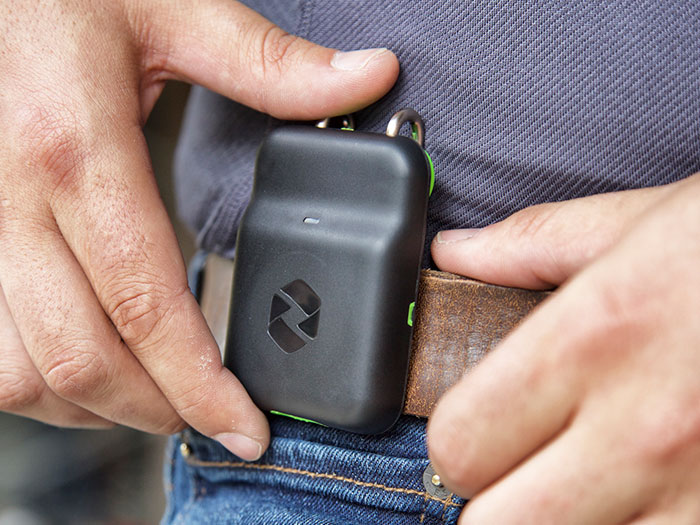Sponsored: Triax Technologies
How the Internet of Things Can Help Solve Construction’s Safety Challenges

Heavy machinery, tall scaffolding, a diverse workforce, and large, chaotic project sites are just some of the factors that make worker safety a top challenge and priority for the construction industry.
“It’s one of the more dangerous industries in the U.S. with disproportionate fatality and injury rates compared to the rest of the working population,” said Pete Schermerhorn, President and Chief Operating Officer, Triax Technologies.
In 2016, construction accounted for 21.1 percent of all private industry fatalities, and falls accounted for 38.7 percent of those fatalities [1]. As a result, construction companies pay some of the highest workers’ compensation premiums.
The construction industry’s reliance on manual processes, paper-based records, and legacy reporting systems also presents safety and risk management challenges for construction managers and insurance professionals because it traps important project information away in a filing cabinet or in the jobsite trailer.
This makes claims management and investigation a challenge, forcing contractors to dig through written reports that can be incomplete or inaccurate. Without a digital database of safety incident information across projects or an organization, contractors and insurers miss an opportunity to seamlessly analyze data to identify trends and risks that can help them build safer in the future.
The Internet of Things (IoT) offers a promising solution to some of these pressing challenges.
Innovative, connected solutions combine a mesh network, wearables and equipment sensors to help solve construction’s safety challenges while boosting productivity and providing unprecedented visibility into safety practices. Spot-r by Triax Technologies is one such solution. Combined with intelligent software and data analytics, this system gives insurers a new look into what’s happening at the jobsite with their contractors.
A Tech-Driven Answer

Pete Schermerhorn, President and Chief Operating Officer
Triax’s cloud-connected worker wearable, the Spot-r Clip, provides an improved, streamlined form of on-site monitoring and communication. With the press of a button, a worker can alert his foreman to an unsafe condition, such as loose scaffolding, or a situation that requires assistance. The supervisor need only check the Spot-r system’s central dashboard to identify the worker’s floor and zone-based location on site.
These sophisticated wearable tags can also detect fall events and collect data around the circumstances of an injury, tracking factors such as the height of a fall and the ambient conditions. The dashboard will also let the supervisor identify who else was in proximity when the incident occurred.
“A wearable device records the fall and tells us when and where the incident occurred,” Schermerhorn said. “It automatically notifies designated personnel, which helps to improve injury response by more than 90 percent, but it also documents critical incident information including a timestamp, distance of fall, and weather on site. This completely streamlines the documentation process and creates a robust digital record that can be used to identify risks in the hopes of preventing future incidents.”
Connecting the Spot-r Clip to the Spot-r EquipTag can also help reduce the risk of non-certified workers taking control of a piece of heavy machinery. The EquipTag adheres to machinery and equipment on site and works with the Spot-r Clip to detect operator identity. The system also checks worker certifications, maintained in the Spot-r dashboard, sending supervisors a notification if there’s an unknown or unauthorized worker in the vicinity of tagged equipment.
In addition, despite today’s tech-advanced world, most site supervisors use nothing more sophisticated than a blowhorn to signal an evacuation. Given the size and high noise level of some job sites, this is not an efficient way to get a message to workers quickly, and every moment of delay further jeopardizes workers’ safety. In the event of a fire or other emergency, evacuation speed is critical, and IoT-enabled alert systems are improving this process.
“With a connected solution, like Spot-r, a general contractor would only need to access the cloud dashboard and click ‘Enable Evacuation’ to sound an alarm on all of the workers’ Clips, as well as a system of mounted evacuation alarms,” Schermerhorn said.
Designed to withstand the challenges of an active construction site, the Spot-r EvacTag can get the message to workers faster with a 100-decibel, flashing alarm, that is also amplified by an audible alarm on each worker’s wearable device.
“Our EvacTags help get people off-site as much as 70 percent faster. The human and safety implications are significant — in an emergency situation, you want to get people out of harm’s way as quickly as possible.” Schermerhorn said.
Productivity Pros
That speed is also a boon for productivity. General contractors are often required by their jurisdictions or their insurance carriers to conduct evacuation drills at regular intervals. If those drills can be completed 70 percent faster, the entire emergency preparation process is much more efficient and effective. When workers or sites view practicing safety as a time-consuming distraction, safety itself can suffer.
There is also great value in digitizing and centralizing this data, eliminating paper processes and the time associated with locating and verifying paper records. Assigning a wearable Clip to every worker helps contactors accurately document where those workers are spending their time on site, allowing foremen to proactively measure progress and adjust scheduling or reassign workers to different tasks as needed.
Similarly, the Spot-r EquipTag optimizes equipment usage by collecting data around a machine’s utilization and active vs. idle time. That information can be used to reassign that equipment to another location where it can be put to better use.
A Solution Built for Construction
The realities of the construction site, however, often impede the use of platform technology that can centralize the data generated by connected devices and make it accessible in real time. Such a system requires reliable connectivity and must have the ability to withstand the dust, vibrations and tough building materials created by construction work.
“A primary challenge is that there’s no fixed structure to attach a network to. The materials in play are constantly moving. Additionally, concrete and steel are difficult to penetrate from a radio frequency standpoint, so it’s tough to maintain a steady connection,” Schermerhorn said.
There also aren’t many places to plug in.
“It’s one of the most inhospitable environments for IoT technology.”
By creating a closed mesh network, Triax’s construction-specific Spot-r solution is not reliant on any existing Wi-Fi networks.
“It exists on its own, which means you’re able to travel throughout the site and stay connected in areas where you might not normally have satellite connectivity,” Schermerhorn said.
Spot-r’s wearable devices and equipment tags are rechargeable and automatically switch on and off, saving a lot of daily hassle.
“The system is low-maintenance and non-invasive,” Schermerhorn said. “It’s solutions like this that are helping to bring construction into the 21st century.”
To learn more, visit https://www.triaxtec.com/workersafety/.
This article was produced by the R&I Brand Studio, a unit of the advertising department of Risk & Insurance, in collaboration with Triax Technologies. The editorial staff of Risk & Insurance had no role in its preparation.










